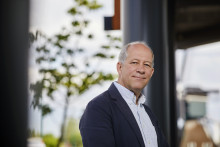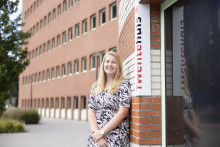There is a lot of money to be made with brilliant failures. When Iske opens the door of his waterside residence in Oostzaan, he has to excuse himself right away. He is talking to a client on the phone who has asked him to research a recent failure. ‘Of course, there are countless management consultants who understand exactly what topics do well at the moment,’ he says when he hangs up the phone. ‘However, I have been working on the cutting edge between knowledge, creativity and innovation for years. I am glad that my perseverance is appreciated and that people recognise the reputation I have built.’
The baby and the bathwater
Iske’s mission is to develop a ‘language’ with which to describe brilliant failures. Just think how many initiatives are lost to history? ‘We are throwing out the baby with the bathwater when we do nothing with failed projects,’ Iske says. ‘There are so many factors that play a role in a project’s success or failure. It is about much more than simply having the right idea. A novelty requires support, the right timing and collaboration, to name just a few factors.’
Here is an example: In 1996, Iske developed a predecessor of the current LinkedIn for his former employer Shell. ‘The idea was simple and good,’ he reflects. ‘A multinational like Shell has a lot of in-house expertise, except people don’t know what their colleagues know. We decided to create a database where all those people and their expertise could be found, alongside some personal information so you know whom you are dealing with. Together with a business partner, I wanted to bring this system – which we called In MASTER (MApping SysTem for ExpeRtise) – to market. What could go wrong?’
It was not a success. ‘Everywhere we went, we were told that our idea was nice, but we first had to help them set up a proper intranet. The internet was still in its infancy. Businesses and institutions were just starting to think about what to do with it. We were simply too early, because LinkedIn did manage to conquer the market six years or so later. I learned an important lesson from that failure: good timing is paramount and being too early with your innovation is not the right time.’
Failing brilliantly
With his Institute of Brilliant Failures, he has put this experience to good use. In his recent book, which bears the same name, he paints scenarios to avoid failures. He also advocates for the taking of acceptable risks. ‘You can fail brilliantly when you did everything right and still don’t quite make it. Nevertheless, a lot of value was created during that process. Take the discovery of Viagra, for example, which was intended to be used as heart medicine. In this case, it was turned into a product that helps people. If the creators had failed to realise its potential, however, all that knowledge would have been thrown out.’
'You can fail brilliantly'
Iske’s passion is to give people and organisations the trust they need to take risks. After graduating cum laude from the Applied Physics programme at the University of Amsterdam, he came to Twente to obtain his doctoral degree under professor Wim Caspers. ‘I got my PhD, with distinction, after four years,’ he says. ‘Still, I had no desire to continue, because I wanted to see more of the world. Mostly, I realised that I am probably not the world’s best researcher. I was not looking forward to being a second-class scientist, which would have been all I could have managed.’

The language of mathematics
Iske left for Shell. ‘I got a job as a researcher. In that prosaic environment of oil refineries and the ugliest machines and factories imaginable, I discovered a wonderful underlying world of mathematics. One of the things I did was work on a catalytic cracker. The tank had to be cleaned by hand every time because particles would stick to the walls. No one knew why that happened. Together with a Russian colleague, I suddenly realised that the process could be described mathematically in the same manner as a satellite in space, which is positioned in the gravitational field of two celestial bodies – the method of ‘Matching Asymptotic Solutions.’ With that knowledge, we were able to describe the process that occurred inside that cracker using the language of mathematics.’
Iske realised his true interest was the search for new answers to existing challenges. After seven years at Shell, he left for ABN AMRO. ‘When my son passed away in an accident, a member of the board of directors told me to take some time, go outside and think about what I truly wanted. That was when I founded Dialogues and called myself Chief Dialogues Officer. I brought people with diverse backgrounds together – not with the goal of tackling predefined problems, but simply to put them in the same room and have them find the connection on their own. That is how the most interesting ideas are born.’
As Chief Dialogues Officer, Iske came into contact with Maastricht University, where he got a job as a professor of Open Innovation one day a week. At the Maastricht University School of Business and Economics, he focuses on ‘Combinatoric Innovation.’ ‘We study opportunities to stimulate dialogue with regards to knowledge. I do so by first determining what knowledge you have and putting it together. A kind of business plan in reverse, simply put. It is not an efficient method, but it is exceptionally effective nonetheless.’
paul iske
1961 Born in Amsterdam
1985 MSc, theoretical physics and mathematics, University of Amsterdam (cum laude)
1989 PhD, theoretical physics, University of Twente (cum laude)
1989 - 1996 Senior research physicist, Shell
1997 - 2015 Chief Dialogues Officer, ABN AMRO
2008 Chief Failure Officer, Institute of Brilliant Failures
2010 Professor of Open Innovation and Business Venturing, School of Business & Economics, Maastricht University
‘View a research proposal like a business case’
These days, Iske combines his Institute of Brilliant Failures with his professorship. His educational background gave him an analytical perspective. When he looks at the academic world, he sees a strong focus on success. ‘I am always surprised to see that acquiring a grant is a cause for celebration, even though that is only the beginning,’ he says. ‘With any research, you face many uncertainties. You can recognise these uncertainties by viewing a research proposal more like a business case. That means you do not have to go as deep and the researcher will receive ‘seed money,’ instead of getting the entire sum in one go.’
Iske says it is all about daring. In March, he gave a talk during the National Research Agenda’s ‘Innovative Risks or Risky Innovation?’ conference. He took the example of the Idea Generator, where researchers can receive a sum of fifty grand for their ‘risky’ projects. ‘I showed images of seven researchers who had all been killed by their own invention; from a cancer researcher who died of a radiation overdose to a researcher of radioactivity. Talk about ‘high risk – high gain’ research.’
Distorted worldview
The academic world’s strong focus on success results in a distorted worldview, Iske says. It is not unlike the news. ‘When you watch the evening news, you might start to believe the world is constantly in crisis. The world of science does the reverse: it sums up its successes, yet hardly anyone ever talks about their failures. It is my mission to create a place for failures. That requires an instrument that tells you which failures are brilliant, because laziness or a lack of interest are not.’
'People in organisations understandably focus too strongly on the risk of damage'
‘However, once that language exists,’ Iske concludes, ‘you can truly learn a lot from failures. You also allow the people in an organisation to try something genuinely new, because they are not judged on their success or lack thereof, but rather on the process leading up to it. People in organisations understandably focus too strongly on the risk of damage. They are afraid that a failure will haunt them for the rest of their career. That is a surefire way to kill innovation. People should be given the opportunity to fail brilliantly; you can get so much out of that.’







